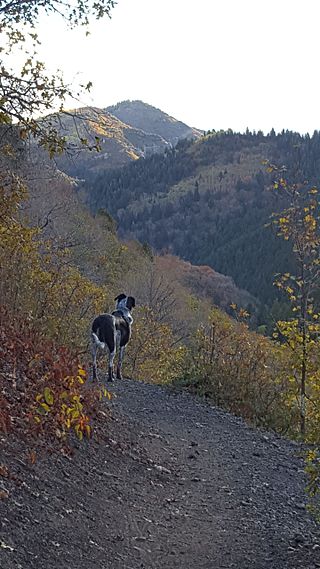Related Research Articles

Wasatch County is a county in the U.S. state of Utah. As of the 2020 United States Census, the population was 34,788. Its county seat and largest city is Heber City. The county was named for a Ute word meaning "mountain pass" or "low place in the high mountains".

Mona is a city in Juab County, Utah, United States. As of the 2010 census it had a population of 1,547. It is part of the Provo–Orem metropolitan area.

The Wasatch Range or Wasatch Mountains is a mountain range in the western United States that runs about 160 miles (260 km) from the Utah-Idaho border south to central Utah. It is the western edge of the greater Rocky Mountains, and the eastern edge of the Great Basin region. The northern extension of the Wasatch Range, the Bear River Mountains, extends just into Idaho, constituting all of the Wasatch Range in that state.

Nebo School District is a public school district that serves the southern part of Utah County.

City Creek is a small but historically important mountain stream that flows from City Creek Canyon and across part of Salt Lake City, Utah, and into the Jordan River which empties into the Great Salt Lake. City Creek's head is about 8 miles (13 km) up City Creek Canyon northeast of Downtown Salt Lake City. The entire stream measures only about 14.5 miles (23 km) long. Melting snow from adjacent mountains provides most of City Creek's currents, but the stream flows year-round because of natural springs at the head of the creek.
The Midwives College of Utah, formerly the Utah School of Midwifery, is an institution of direct-entry midwifery training that is headquartered in Salt Lake City, Utah but offers all programs completely online. Founded in 1980, it is one of the largest and longest-standing direct-entry (out-of-hospital) midwifery programs in the nation. It has been accredited through the Midwifery Education Accreditation Council (MEAC) since 1996, which is approved by the U.S. Secretary of Education as a nationally recognized accrediting agency. The school is also accepted by the California Medical Board for state licensure.

The Salt Creek Canyon massacre occurred on June 4, 1858, when four Danish immigrants were ambushed and killed by unidentified Indians in Salt Creek Canyon, a winding canyon of Salt Creek east of present-day Nephi, in Juab County, Utah.

Millcreek Canyon is a canyon in the Wasatch Mountains and part of Millcreek City on the east side of the Salt Lake Valley, Utah. It is a popular recreation area both in the summer and in the winter. It was named by Brigham Young on August 22, 1847, before all of the mills that were built in and below the densely forested canyon. It is home to two restaurants and six Boy Scout Day Camps.
Rainwater Creek is a 3.9-mile-long (6.3 km) tributary stream of Lake Fork Creek. It flows into Lake Fork Creek downstream from the Lake Fork Reservoir Dam approximately four miles west of Quitman in western Wood County, Texas. Its primary source is a spring, augmented by stormwater runoff. It is named for the family of William Walton Rainwater, who was among the earliest permanent settlers of the area.

The Nez Perce native Americans fled through Yellowstone National Park between August 20 and Sept 7, during the Nez Perce War in 1877. As the U.S. army pursued the Nez Perce through the park, a number of hostile and sometimes deadly encounters between park visitors and the Indians occurred. Eventually, the army's pursuit forced the Nez Perce off the Yellowstone plateau and into forces arrayed to capture or destroy them when they emerged from the mountains of Yellowstone onto the valley of Clark's Fork of the Yellowstone River.

Peteetneet Creek is a stream in Payson Canyon, south of Payson, Utah, United States.
Juab is a ghost town in Juab County, Utah, United States. It lies at an elevation of 5,082 feet (1,549 m), and is 5.1 miles (8.2 km) west-southwest of Levan.
Dalton Creek is a stream in Morgan County, Utah, United States. A tributary of the Weber River, it is located within the Uinta-Wasatch-Cache National Forest and its mouth is about 1.75 miles (2.82 km) southeast of Peterson.
Davenport Creek is a stream in Cache County, Utah, United States. It is also located within the Uinta-Wasatch-Cache National Forest and its mouth is about 2 miles (3.2 km) southeast of Avon. The creek rises in the Bear River Mountains and flows briefly southwest. It then turns northwest and runs in that direction for most of its course before emptying into the South Fork Little Bear River at a point immediately west of Utah State Route 162. The main tributaries of Davenport Creek are Pole Creek, Bald Head Creek, Smith Creek, and Fish Creek.
Days Canyon is a canyon in the Wasatch Range in eastern Utah County, Utah, United States.
Hobble Creek is a stream in Utah County, Utah. Its mouth lies at at its confluence with Utah Lake, at an elevation 4,491 feet (1,369 m). Its source is located at 40°09′45″N111°30′03″W, at the confluence of the Left Fork and Right Fork Hobble Creek in the Wasatch Range. The source lies at an elevation 5,043 feet (1,537 m). The unincorporated community of Hobble Creek occupies the valley of the creek and its Left Fork.
Chalk Creek is a stream in Millard County, Utah, United States.
Panther Creek is a stream in Webster and Laclede counties in the Ozarks of south-central Missouri. It is a tributary of the Osage Fork Gasconade River. The headwaters are at 37°29′09″N92°49′42″W and the confluence with the Osage Fork is at 37°28′48″N92°42′44″W.
Currant Creek is a stream in eastern Juab County and southern Utah County in northern Utah, United States.
References
39°42′44″N111°48′43″W / 39.71222°N 111.81194°W